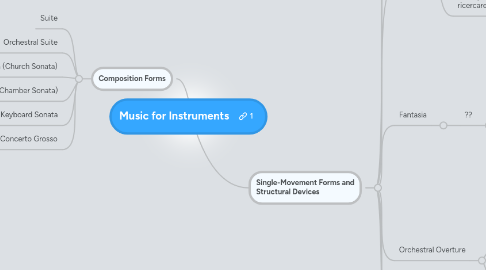
1. Single-Movement Forms and Structural Devices
1.1. Toccata
1.1.1. A keyboard composition written in a free keyboard style
1.1.2. Uses full chords and running passages
1.1.3. The earliest toccatas only consist of full chords and interlacing scale passages
1.2. Prelude
1.2.1. Designed to be played as an introduction to another composition
1.2.2. With few exceptions, the prelude has always been restricted to instrumental solo music, that is, to keyboard instruments and the lute.
1.3. Ricercar
1.3.1. A term used during the 16th and 17th centuries
1.3.1.1. Instrumental music that differs considerably in style and purpose
1.3.2. Imitative (countrapuntal) ricercar
1.3.2.1. Can be divided into two categories; the ensemble ricercar and the organ ricercar
1.3.3. Non-imitative ricercar
1.3.3.1. These were written for lute, organ and viols
1.4. Fugue
1.4.1. A piece of music where a theme (or themes) is extended and developed.
1.4.1.1. This is usually done by imitative counterpoint.
1.4.2. Fugal writing, in the modern sense, first appears in 16th-century vocal polyphony and in instrumental forms, including the ricercare, fantasia and canzone.
1.5. Fantasia
1.5.1. ??
1.5.1.1. Pieces of a improvisory character; written records of the improvisation technique of the various composers.
1.5.1.2. Character pieces of the romantic era.
1.5.1.2.1. Here "fantasia" is one of the various titles used to indicate a dreamlike mood.
1.5.1.3. Sonatas in free form, or of a special nature.
1.5.1.4. Operatic potpourris ( musical form structured as ABCDEF) of a free and somewhat improvised treatment, as if written in remembrance of a performance.
1.5.1.5. In the 16th and 17th centuries, a term for instrumental music that was sometimes used interchangeably with ricercar.
1.6. Orchestral Overture
1.6.1. An orchestral piece introducing an opera or other longer work.
1.6.2. Overtures to mid-17th-century Venetian operas typically consisted of a slow section in two followed by a faster one in three
1.7. Theme and Variation
1.7.1. There are four basic kinds of variation
1.7.1.1. A variation that preserves both melody (though perhaps with new ornamentation) and harmony of the theme.
1.7.1.2. One that preserves the essential harmony of the theme.
1.7.1.3. One in which the harmonies deviate but the over-all structure, such as the number of measures, the structure of sections and phrases, and cadential endings, is preserved.
1.7.1.4. The entirely free variations of modern composers in which even the structural outlines of the theme are no longer recognizable.
1.8. Ritornello Form
1.8.1. A term often used for the typical form of the first and frequently also the last movement of the baroque concerto, particularly the concerto grosso.
1.8.1.1. Such movements consist of an alternation of tutti and solo sections, the tutti sections being based on identical material while the solo sections vary. The tutti sections therefore form the ritornello.
1.9. Passacaglia and Chaconne
1.9.1. Two closely related forms of the Baroque era.
1.9.1.1. Each a kind of continuous variation.
1.9.2. Bach
1.9.2.1. A passacaglia is a continuous variation based on a clearly distinguishable ostinato that normally appears in the bass but that may occasionally be transferred to an upper voice.
1.9.2.2. A chaconne is a continuous variation in which the "theme" is a scheme of harmonies usually treated so that the first and last chords are fixed whereas the intervening ones can be replaced by substitutes.
1.10. Chorale Prelude
1.10.1. A polyphonic composition for organ based on a chorale melody
